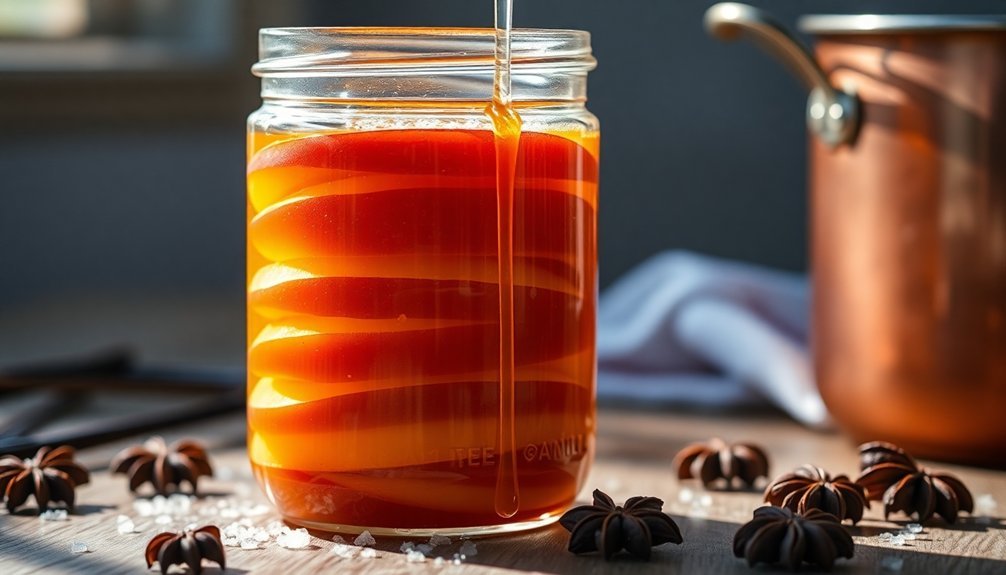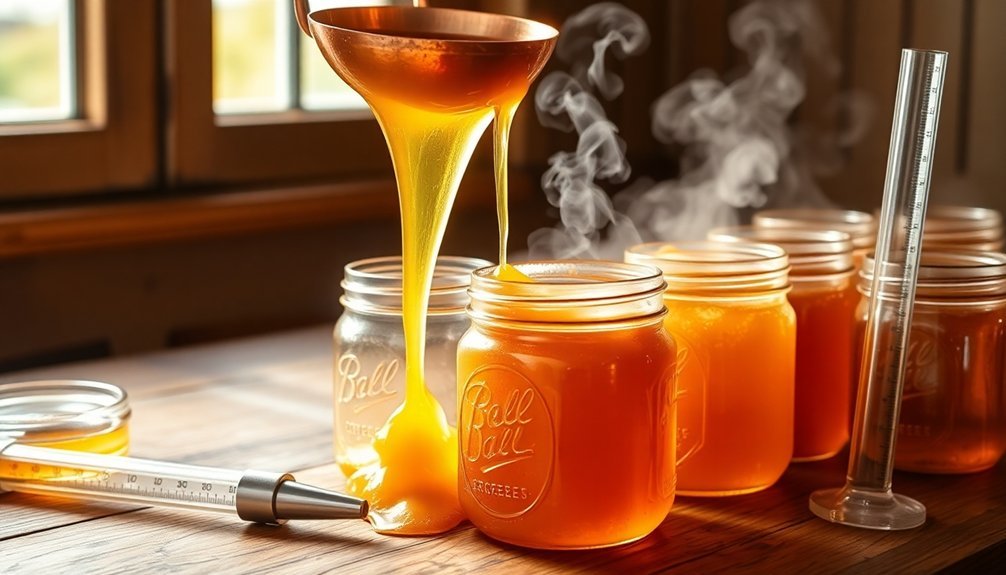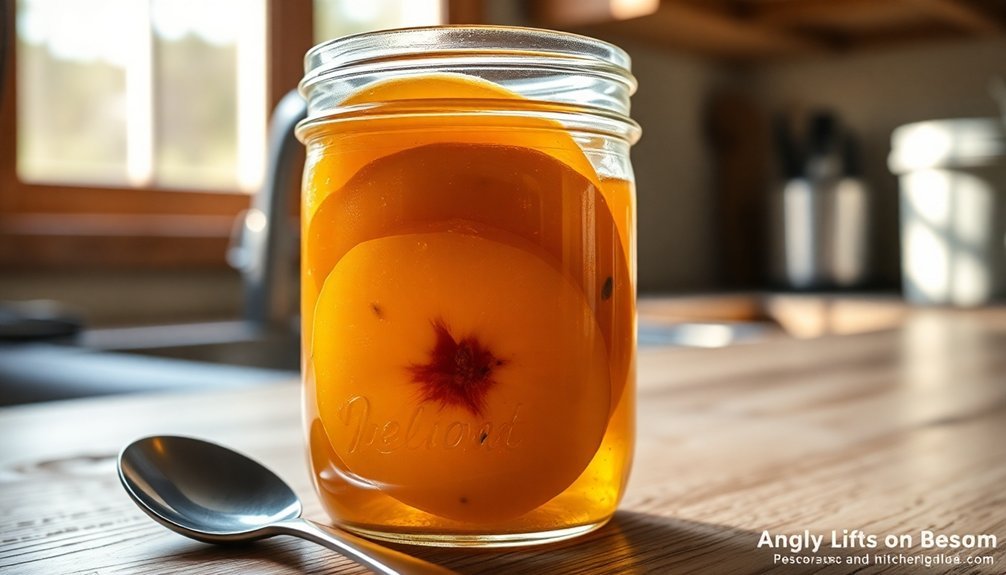Seven proven sugar syrup preservation methods can help you extend your food's shelf life naturally. Traditional fruit canning uses varying syrup concentrations, while sugar syrup freezing keeps berries fresh year-round. Crystalline sugar dehydration removes moisture effectively, and osmotic dehydration uses concentrated solutions to preserve fruits. Fermentation combines sugar with beneficial bacteria for enhanced preservation, while standard preservative solutions follow specific sugar-to-water ratios. Temperature-controlled processing guarantees food safety through precise heating requirements. These time-tested techniques offer a wealth of preservation options waiting to transform your food storage approach.
Traditional Fruit Canning With Syrup

Setting up your fruit canning project starts with making the right sugar syrup. You'll need to choose between three main syrup concentrations: extra-light (1 1/4 cups sugar to 10 1/2 cups water), light (2 1/4 cups sugar to 9 cups water), or medium (3 3/4 cups sugar to 8 1/4 cups water).
Select your syrup based on the fruit's natural sweetness and your taste preferences. Fresh, ripe fruit produces the highest quality preserves.
To prepare your syrup, combine the sugar and water in a saucepan and heat until the sugar dissolves completely. Bring the mixture to a full rolling boil, and skim off any foam that forms on top.
Keep the syrup warm while you're working with your fruit.
You can pack your fruit using either the raw or hot pack method. For raw pack, you'll pour the hot syrup over fresh fruit in jars. If you're using hot pack, add your fruit to the boiling syrup first, return it to a boil, then fill your jars.
Remember to leave a 1/2-inch headspace and remove air bubbles. If you're looking for alternatives, you can substitute the sugar syrup with fruit juice, honey, or other natural sweeteners while following the same processing guidelines.
Sugar Syrup Freezing Methods
Beyond traditional canning methods, freezing with sugar syrup offers another effective way to preserve fruit. You'll need to prepare a 50% syrup solution by mixing equal parts sugar and water by weight, ensuring the sugar dissolves completely in lukewarm water before cooling it for use. Vitamin C tablets can be crushed and added to prevent browning of light-colored fruits.
When you're ready to freeze your fruit, pack whole berries in containers and cover them with the cold syrup, or mix berries directly with sugar (3/4 cup per quart). Don't forget to leave headspace for expansion during freezing. You'll want to keep the fruit submerged using crumpled plastic wrap before sealing.
| Preservation Step | Benefits |
|---|---|
| Sugar Syrup Use | Maintains better texture and color |
| Proper Sealing | Prevents freezer burn and oxidation |
| Headspace Allowance | Accommodates expansion during freezing |
| Quick Freezing | Preserves fruit quality and nutrients |
For the best results, you'll need to store your frozen fruit at consistent freezer temperatures for up to one year. When you're ready to use it, thaw the fruit in your refrigerator for 6-8 hours, or use cold running water for faster results. Remember, slightly underthawed fruit maintains a firmer texture, especially if you've used sugar syrup in your preservation method.
Crystalline Sugar Dehydration Techniques

Through modern dehydration techniques, you can effectively preserve food using crystalline sugar solutions and specialized catalysts.
You'll need to work with substituted sulfonic acid catalysts, which are particularly effective because they're soluble in aqueous sugar solutions and can be recovered for reuse.
When you're dehydrating sugar solutions, you'll want to maintain specific temperature conditions and monitor the water-to-ethanol ratio carefully.
It's essential that you cool the dehydration products quickly to prevent unwanted secondary reactions.
You can apply this process to both regular sugars and sugar alcohols from pentoses and hexoses. This preservation method has been proven effective as sugar inhibits bacteria and other harmful microorganisms.
To separate the dehydration products from residual sugars and catalysts, you'll have several options at your disposal.
You can use solvent extraction, chromatographic methods, or adsorption/desorption techniques.
For continuous processing, you'll find that flow-through testing of adsorbents works well for separating components like HMF from residual sugars.
You can further process these dehydration products to create ester and ether derivatives through acid-catalyzed reactions.
The process is versatile enough to work with various sugar solutions, including commercial high fructose corn syrup, making it practical for different preservation needs.
Fermented Sugar Preservation
When you're preserving food through sugar fermentation, you're actually leveraging two powerful preservation mechanisms simultaneously. The sugar creates an osmotic effect that reduces water activity, while beneficial bacteria convert these sugars into natural preservatives like ethanol and lactic acid. This dual action makes fermented sugar preservation particularly effective at keeping food safe.
You'll find this process most active during the first 10 days, when you'll notice bubbling and microbial activity in your fermentation container. The anaerobic environment you create by using closed containers helps select for beneficial bacteria while inhibiting harmful ones.
If you're working with vegetables, you'll want to combine salt with sugar, as this helps draw out moisture and creates the perfect environment for fermentation.
You can apply these principles to create various preserved foods. Whether you're making sauerkraut, kimchi, or fermented dairy products, you'll be using the same core process.
The fermentation not only preserves your food but also enhances its nutritional value by creating probiotics and maintaining vitamin content. Remember to control temperature and moisture levels to ascertain successful fermentation.
Creating Preservative Sugar Solutions

You'll find that creating effective preservative sugar solutions starts with mastering the basic 1:1 ratio of sugar to water by weight for standard syrup preparations.
For enhanced preservation, you can heat your syrup to 186°F for quick pasteurization or maintain it at 140°F for 10 minutes to eliminate harmful microorganisms.
When preserving fruit, you'll need to adjust these ratios to match your specific needs, using 1¾ cups of sugar to 4 cups of water for a medium syrup or 1 cup of sugar per 2-3 pounds of fruit for dry sugar packing.
Basic Syrup Ratios Guide
Understanding basic syrup ratios forms the foundation of successful food preservation with sugar solutions.
You'll find that the standard simple syrup uses a 1:1 ratio of water to sugar, but you can adjust this ratio to create richer or leaner syrups based on your needs. For longer preservation, you'll want to take into account using specific ratios designed for canning.
When preserving fruits with naturally high sugar content, opt for a very light syrup using 6.5 cups water to 0.75 cups sugar. This 10% sugar content works well for berries and grapes while maintaining their natural flavors.
For more universal preservation, you'll want to use medium syrup, which combines 5.25 cups water with 2.25 cups sugar, creating a 30% sugar solution ideal for apples and cherries.
You can enhance your syrup's preservation properties by adding citric acid or cream of tartar.
For extended shelf life, consider incorporating sodium benzoate or potassium sorbate at 0.1% by weight.
While you can use honey or other sweeteners, they may require additional preservation methods.
Avoid using sugar alternatives like Splenda for long-term preservation, as they lack the necessary preservative properties.
Heat Treatment Temperature Points
Proper heat treatment stands as a critical factor in creating effective sugar-based preservative solutions. When you're preparing your syrup, you'll typically need to heat it to around 95℉ (35℃) to guarantee proper dissolution and initial pasteurization.
However, you should be aware that traditional heat pasteurization comes with specific challenges you'll need to manage. While heat treatment can sterilize your syrup, it won't necessarily eliminate all thermoresistant spores, which could potentially compromise your preservation efforts.
You'll find that maintaining the required high temperatures consumes significant energy and requires constant monitoring to prevent taste and quality degradation.
You might want to take into account alternative methods like UV disinfection, which offers several advantages over traditional heat treatment. It's more energy-efficient, works faster, and won't alter your syrup's taste or appearance.
Most importantly, UV treatment proves more effective at neutralizing harmful microorganisms, including those stubborn thermoresistant spores that often survive heat pasteurization.
When choosing your preservation method, you'll need to weigh these factors carefully. While heat treatment remains widely used, its limitations in spore elimination and energy efficiency make alternative methods increasingly attractive for modern syrup preservation.
Sugar Syrup Temperature Control
Temperature control plays an essential role in creating and preserving sugar syrups effectively. You'll need to monitor specific temperature points to achieve the desired results and guarantee proper preservation. When pasteurizing your syrup, you can choose between heating it to 186°F for 6 seconds or maintaining it at 140°F for 10 minutes.
| Process | Temperature Requirements |
|---|---|
| Basic Pasteurization | 186°F for 6 seconds |
| Extended Pasteurization | 140°F for 10 minutes |
| Hot Filling | Minimum 120°F |
| Inversion Process | 240°F with acid catalyst |
| Sugar Concentration | 233°F for 80% solution |
For invert syrup production, you'll want to maintain 240°F while adding cream of tartar or lemon juice. The sugar concentration affects the boiling point – an 80% sugar solution boils at 233°F. You can use this relationship to determine your syrup's concentration by measuring its boiling point.
When you're done processing, fill your sterilized jars while the syrup's still warm. Cap them immediately and invert the jars to create a vacuum seal as they cool. This method, combined with proper temperature control during processing, guarantees your syrup stays preserved longer.
Osmotic Dehydration Using Syrups

Drawing on the power of osmotic pressure, concentrated sugar solutions effectively remove moisture from fruits and vegetables through a process called osmotic dehydration. You'll find sucrose is the most common osmotic agent, though you can also use alternatives like glucose, fructose, or sugar alcohols, which help preserve carotenoids in your food.
To achieve the best results, you'll need to control several key factors. Use a fruit-to-solution ratio of 1:4 and maintain temperatures below 50°C to prevent nutrient loss. The concentration of your sugar solution directly affects moisture removal – higher concentrations lead to greater water loss. You can expect significant weight reductions, with some fruits like melon showing losses up to 64.98% when using 60°Bx sucrose solutions for 180 minutes.
You can enhance the dehydration process by combining it with other techniques. For instance, using ultrasound as a pretreatment improves water loss in fruits like persimmon.
After osmotic dehydration, you can further dry your products using convection dryers to achieve lower water activity. This method eliminates the need for additional preservatives while maintaining food quality and safety.
Frequently Asked Questions
Can I Substitute Maple Syrup for Sugar Syrup in Food Preservation Methods?
You shouldn't substitute maple syrup for sugar syrup in food preservation, as it's less effective at preventing spoilage. Its higher water content and lower sugar concentration won't safely preserve your food like traditional sugar syrup.
How Long Will Fruits Preserved in Sugar Syrup Last at Room Temperature?
You shouldn't store fruits in sugar syrup at room temperature – it's unsafe and risks spoilage. You'll need to refrigerate your preserved fruits or use proper canning methods for safe, long-term storage.
Does Adding Spices to Sugar Syrup Affect Its Preservation Properties?
Yes, spices can enhance your sugar syrup's preservation properties. You'll get antimicrobial benefits from spices like cinnamon and cloves, while antioxidant-rich options like ginger can help prevent spoilage. Just don't overuse them.
Why Do Some Preserved Fruits Float to the Top of Syrup?
Your fruits float because they're less dense than the syrup, often due to trapped air in their cells. This can happen when you use under-ripe fruit, pack them too loosely, or process them incorrectly.
Can Sugar-Preserved Foods Be Safely Consumed by Diabetics?
You'll need to limit sugar-preserved foods if you're diabetic, as they contain high sugar levels. While you can consume them occasionally in small amounts, it's best to choose alternative preservation methods instead.
In Summary
You've now learned seven reliable methods for preserving food with sugar syrups – from traditional canning to advanced osmotic dehydration. You'll find these techniques work well for different types of produce and storage needs. Whether you're preserving summer fruits or creating fermented delicacies, you can trust these time-tested approaches. Remember to always follow proper safety protocols and temperature guidelines for the best results.





Leave a Reply